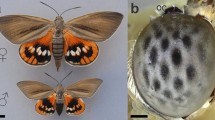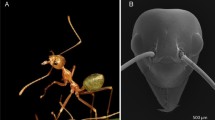Abstract
The presence of a specialised dorsal rim area with an ability to detect the e-vector orientation of polarised light is shown for the first time in a nocturnal hymenopteran. The dorsal rim area of the halictid bee Megalopta genalis features a number of characteristic anatomical specialisations including an increased rhabdom diameter and a lack of primary screening pigments. Optically, these specialisations result in wide spatial receptive fields (Δρ = 14°), a common adaptation found in the dorsal rim areas of insects used to filter out interfering effects (i.e. clouds) from the sky. In this specialised eye region all nine photoreceptors contribute their microvilli to the entire length of the ommatidia. These orthogonally directed microvilli are anatomically arranged in an almost linear, anterior–posterior orientation. Intracellular recordings within the dorsal rim area show very high polarisation sensitivity and a sensitivity peak within the ultraviolet part of the spectrum.





Similar content being viewed by others
References
Aepli F, Labhart T, Meyer EP (1985) Structural specializations of the cornea and retina at the dorsal rim of the compound eye in hymenopteran insects. Cell Tissue Res 239:19–24
Barta A, Horvath G (2004) Why is it advantageous for animals to detect celestial polarization in the ultraviolet? Skylight polarization under clouds and canopies is strongest in the UV. J Theor Biol 226:429–437
Blum M, Labhart T (2000) Photoreceptor visual fields, ommatidial array, and receptor axon projections in the polarisation-sensitive dorsal rim area of the cricket compound eye. J Comp Physiol A 186:119–128
Brines ML, Gould JL (1982) Skylight polarisation patterns and animal orientation. J Exp Biol 96:69–91
Burghause FMHR (1979) Die strukturelle Spezialisierung des dorsalen Augenteils der Grillen (Orthopera, Grylloidea). Zool Jb Physiol 83:502–525
Coulson KL (1988) Polarization and intensity of light in the atmosphere. A. Deepak Publishing, Hampton
Cronin TW, Warrant EJ, Greiner B (2006) Celestial polarization patterns during twilight. Appl Opt 45:5582–5589
Dacke M, Nilsson DE, Warrant EJ, Blest AD, Land MF, O’Carroll DC (1999) Built-in polarizers form part of a compass organ in spiders. Nature 401:470–473
Dacke M, Nordstrom P, Scholtz CH, Warrant EJ (2002) A specialized dorsal rim area for polarized light detection in the compound eye of the scarab beetle Pachysoma striatum. J Comp Physiol A 188:211–216
Dacke M, Nilsson DE, Scholtz CH, Byrne M, Warrant EJ (2003) Animal behaviour: insect orientation to polarized moonlight. Nature 424:33
Dacke M, Byrne MJ, Scholtz CH, Warrant EJ (2004) Lunar orientation in a beetle. Proc R Soc Lon B Biol Sci 271:361–365
Duelli P, Wehner R (1973) The spectral sensitivity of polarized light orientation in Cataglyphis bicolor (Formicidae, Hymenoptera). J Comp Physiol A 86:37–53
Egelhaaf A, Dambach M (1983) Giant rhabdomes in a specialized region of the compound eye of a cricket—Cycloptiloides canariensis (Insecta, Gryllidae). Zoomorph 102:65–77
Eggers A, Gewecke M (1993) The dorsal rim area of the compound eye and polarisation vision in the desert locust (Schistocerca gregaria). In: Wiese K, Gribakin FG, Popov AV, Renninger G (eds) Sensory systems of arthropods. Birkhäuser, Basel, pp 101–109
Gál J, Horváth G, Barta A, Wehner R (2001) Polarization of the moonlit clear night sky measured by full-sky imaging polarimetry at full moon: comparison of the polarization of moonlit and sunlit. J Geophys Res 106:22647–22653
Goldsmith TH, Wehner R (1977) Restrictions on rotational and translational diffusion of pigment in the membranes of a rhabdomeric photoreceptor. J Gen Physiol 70:453–490
Greiner B, Ribi WA, Warrant EJ (2004) Retinal and optical adaptations for nocturnal vision in the halictid bee Megalopta genalis. Cell Tissue Res 316:377–390
Herzmann D, Labhart T (1989) Spectral sensitivity and absolute threshold of polarization vision in crickets—a behavioral study. J Comp Physiol A 165:315–319
Homberg U, Paech A (2002) Ultrastructure and orientation of ommatidia in the dorsal rim area of the locust compound eye. Arthropod Struct Dev 30:271–280
Kelber A, Warrant EJ, Pfaff M, Wallen R, Theobald JC, Wcislo WT, Raguso R (2006) Light intensity limits the foraging activity in nocturnal and crepuscular bees. Behav Ecol 17:63–72
Kleinlogel S, Marshall J, Horwood JM, Land MF (2006) Neuroarchitecture of the color and polarisation vision system of the stomatopod Haptosquilla. J Comp Neurol 467:326–342
Labhart T (1980) Specialized photoreceptors at the dorsal rim of the honeybee’s compound eye: polarizational and angular sensitivity. J Comp Physiol A 141:19–30
Labhart T (1986) The electrophysiology of photoreceptors in different eye regions of the desert ant, Cataglyphis bicolor. J Comp Physiol A 158:1–7
Labhart T (1999) How polarization-sensitive interneurones of crickets see the polarization pattern of the sky: a field study with an opto-electronic model neurone. J Exp Biol 202:757–770
Labhart T, Meyer EP (1999) Detectors for polarized skylight in insects: a survey of ommatidial specializations in the dorsal rim area of the compound eye. Microsc Res Tech 47:368–379
Labhart T, Hodel B, Valenzuela I (1984) The physiology of the cricket’s compound eye with particular reference to the anatomically specialized dorsal rim area. J Comp Physiol A 155:289–296
Laughlin SB, Menzel R, Snyder AW (1975) Membranes, dichroism and receptor senstivity. In: Snyder AW, Menzel R (eds) Photoreceptor optics. Springer, Heidelberg, pp 237–259
Meyer EP, Labhart T (1981) Pore canals in the cornea of a functionally specialized area of the honey bee’s compound eye. Cell Tissue Res 216:491–501
Nilsson DE, Warrant EJ (1999) Visual discrimination: Seeing the third quality of light. Curr Biol 9:535–537
Nilsson D-E, Labhart T, Meyer E (1987) Photoreceptor design and optical properties affecting polarization sensitivity in ants and crickets. J Comp Physiol A 161:645–658
Ribi WA (1976) A Golgi-electron microscope method for insect nervous tissue. Stain Technol 51:13–16
Ribi WA (1978) A unique hymenopteran compound eye. The retina fine structure of the digger wasp Sphex cognatus Smith (Hymenoptera, Shecidae). Zool Jb Anat 100:299–342
Riley JR, Reynolds DR (1986) Orientation at night by high-flying insects. In: Danthanarayana W (ed) Insect flight: dispersal and migration. Springer, Heidelberg, pp 71–87
Rossel S (1989) Polarization sensitivity in compound eyes. In: Stavenga DG, Hardie RC (eds) Facets of vision. Springer, Heidelberg, pp 298–316
Rozenberg GV (1966) Twilight: a study in atmospheric optics. Plenum Press, New York
Schinz RH (1975) Structural specialization in the dorsal retina of the bee, Apis mellifera. Cell Tissue Res 162:23–34
Shaw SR (1975) Retinal resistance barriers and electrical lateral inhibition. Nature 255:480–482
Sommer EW (1979) Untersuchungen zur topographischen Anatomie der Retina und zur Sehfeldtopologie im Auge der Honigbiene, Apis mellifera (Hymeoptera). Universität Zürich
von Frisch K (1949) Die Polarisation des Himmelslichtes als orientierender Faktor bei den Tänzen der Bienen. Experientia 5:142–148
von Frisch K (1965) Die Tanzsprache und Orientierung der Bienen. Springer, Heidelberg
von Helversen O, Edrich W (1974) Der Polarisationsempfänger im Bienenauge: ein Ultraviolettrezeptor. J Comp Physiol 94:33–47
Warrant EJ, McIntyre PD (1993) Arthropod eye design and the physical limits to spatial resolving power. Prog Neurobiol 40:413–461
Warrant EJ, Kelber A, Gislén A, Greiner B, Ribi W, Wcislo WT (2004) Nocturnal vision and landmark orientation in a tropical halictid bee. Curr Biol 14:1309–1318
Waterman TH (1981) Polarization sensitivity. In: Autrum H (ed) Handbook of sensory physiology. Springer, Heidelberg, pp 281–469
Wcislo WT, Arneson L, Roesch K, Gonzalez V, Smith A, Fernandez H (2004) The evolution of nocturnal behaviour in sweat bees, Megalopta genalis and M. ecuadoria (Hymenoptera: Halictidae): an escape from competitors and enemies? Biol J Linn Soc 83:377–387
Wehner R (1981) Spatial vision in arthropods. In: Autrum H (ed) Handbook of sensory physiology. Springer, Heidelberg, pp 287–616
Wehner R (1997) The ant’s celestial compass system: spectral and polarisation channels. In: Lehrer M (ed) Orientation and communication in arthropods. Birkhäuser, Basel, pp 145–185
Wehner R, Labhart T (2006) Polarisation Vision. In: Warrant EJ, Nilsson DE (eds) Invertebrate vision. Cambridge University Press, Cambridge, pp 291–348
Wehner R, Bernard GD, Geiger E (1975) Twisted and non-twisted rhabdoms and their significance for polarization detection in the bee. J Comp Physiol 104:225–245
Acknowledgments
We would like to thank Thomas Labhart for valuable comments on the manuscript, Jamie Theobald for help with fieldwork and the staff of the Smithonian Tropical Research Institute for their help and ANAM of the Republic of Panama for permission to collect and export bees for this study. The histological work was partly done at the Centre for Visual Sciences, Research School of Biological Sciences, Australian National University. B.G. is thankful for travel awards from the Royal Physiographic Society, the Per Westlings Fond, the Foundation of Dagny and Eilert Ekvall and the Royal Swedish Academy of Sciences. E.J.W. is grateful for the support of a Smithsonian Short-Term Research Fellowship, the Swedish Research Council, the Crafoord Foundation, the Wenner-Gren Foundation and the Royal Physiographic Society of Lund for their ongoing support. W.T.W. is grateful for general research funds from STRI and T.W.C for support from the NSF and the Air Force Office of Scientific Research.
Author information
Authors and Affiliations
Corresponding author
Rights and permissions
About this article
Cite this article
Greiner, B., Cronin, T.W., Ribi, W.A. et al. Anatomical and physiological evidence for polarisation vision in the nocturnal bee Megalopta genalis . J Comp Physiol A 193, 591–600 (2007). https://doi.org/10.1007/s00359-007-0214-1
Received:
Revised:
Accepted:
Published:
Issue Date:
DOI: https://doi.org/10.1007/s00359-007-0214-1




